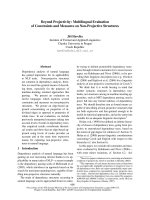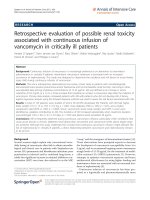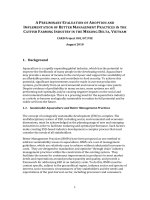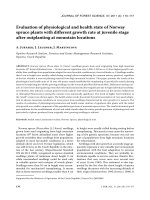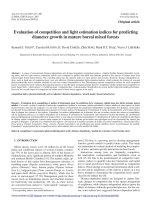Evaluation of hazard and exposure associated with nanosilver and other nanometal oxide pesticide products
Bạn đang xem bản rút gọn của tài liệu. Xem và tải ngay bản đầy đủ của tài liệu tại đây (2.2 MB, 73 trang )
Evaluation of Hazard and Exposure
Associated with Nanosilver and Other
Nanometal Oxide Pesticide Products
Presented by:
Murray J. Height, Ph.D.
Chief Technology Officer
HeiQ Materials
www.heiqmaterials.com
Presented on behalf of the Silver Nanotechnology Working Group (SNWG), an
industry effort intended to foster the collection of data on silver and nanotechnology in
order to advance the science and public understanding of the beneficial uses of silver
nanoparticles in a wide-range of consumer and industrial products.
FIFRA SCIENTIFIC ADVISORY PANEL (SAP)
OPEN CONSULTATION MEETING
November 3 - 6, 2009
Arlington VA
Also refer to docket submission:
JL.Delattre, R.Volpe, “Comments of The
Silver Nanotechnology Working Group
for Review by The FIFRA Scientific
Advisory Panel”, SNWG (2009).
Outline
1. Commercial and regulatory history of nanoscale silver
2. Human health perspective
3. Ecological perspective
4. Policy perspective
2
Outline
1. Commercial and regulatory history of nanoscale silver
2. Human health perspective
3. Ecological perspective
4. Policy perspective
3
Nanoscale Silver – Perspective
• Origins of nanoscale silver and terminology
• Uses of nanoscale silver
• Regulatory status for antimicrobial nanosilver products
• Value of nanosilver products as antimicrobials (subject to FIFRA)
4
Nanoscale Silver - Origins
• Scientific origins of silver nanoparticles buried within colloidal science
• Colloidal sols are small solid particles suspended in a solvent
• Colloidal silver produced since 1800s (and earlier)
• Colloidal silver particles are synthesized through many methods1:
– Liquid phase reduction reactions
– Electrolytic methods
These methods are also
– Vapor methods
used to produce silver
nanoparticles today
– Mechanical milling
– etc.
• Colloidal silver clearly rationally engineered particles of small size
• Are they well characterised?
• What is their size?
1
A.Ede,”The rise and decline of colloid science in North America, 1900-1935. The neglected dimension”, Science, Technology and Culture 1700-1945 series, Ashgate
Publishing (2007).
5
Nanoscale Silver - Origins
• Characterisation: Colloidal metals and colloidal silver
• Particle size <100nm accurately determined via a number of historical methods:
ca.1903
ca.1907
ca.1917
ca.1923
Ultramicroscopes (light scattering optical microscope)1,2
Dialysis (relative permeability)3
Electrophoresis (motion in electric field)4
Ultracentrifuges (sedimentation correlation to particle size)5,6
4 µµ = 4 x10-9 m
= 4 nm
Millimicron (µµ) = nanometer (nm)
[2]
[6]
1
H.Siedentopf, R.Zsigmondy, „Über Sichtbarmachung und Grössenbestimmung ultramikroskopischer Teilchen, mit besonderer Anwendung auf Goldrubingläser“,
Annalen der Physik 10 (1903) pp1-10.
2 R.Zsigmondy, “Properties of colloids”, Nobel Lecture, December 11 (1926).
3 H.Bechhold, “Die Gallertfiltration”, Zeitschrift für Chemie und Industrie der Kolloide, 2(1) (1907) pp3-9.
4 TR, Briggs, “Electrical endosmose I”, Journal of Physical Chemistry, 21(3) (1917) pp198–237.
5 T.Svedberg, JB.Nichols, “Determination of size and distribution of size of particles by centrifugal methods”, Journal American Chemistry Society, 45 (1923) pp2910-17.
6 T.Svedberg, “The ultracentrifuge”, Nobel Lecture, May 19 (1927).
6
Nanoscale Silver - Origins
• 1969. Carey Lea colloidal silver
produced using same methodology
as 18891
• Size determination and
characterisation using electron
microscopy (TEM) confirms the size
from historical characterisation
methods2
• Carey Lea colloidal silver
average size 7 - 10 nm
• Confirmed as metallic silver by Xray diffraction
• Colloidal silver shown as particles
within range of 1 to 100nm
1
MC. Lea, “On Allotropic Forms of Silver”, American Journal of Science, 37
(1889) 476.
2 G.Frens, J.Th.G.Overbeek, "Carey Lea's colloidal silver", Kolloid-Zeitschrift
und Zeitschrift für Polymere, 233(1-2) (1969) pp922-929.
[2]
7
Nanoscale Silver - Origins
• Silver particles in the nano size range show a yellow/brown color1
• This color derives from the surface plasmon effect and is a unique
identifier of silver metal particles in the nano size range2
• Colloidal silver shares same silver metal properties as silver
nanoparticles1,2
4 different colloidal silver
commerical products
Yellow/brown color is a
scientifically wellestablished characteristic
of silver nanoparticles
Size (DLS)3
35 nm
20–110 nm
25-95 nm
2 nm
All show nano size range
1
A.Moores, F.Goettmann “The plasmon band in noble metal nanoparticles: an introduction to theory and applications”, New Journal of Chemistry, 30 (2006) pp1121-1132.
VK.Sharma, RA.Yngard, Y.Lin, “Silver nanoparticles: green synthesis and their antimicrobial activites", Advances in Colloid Science and Interface Science, 145 (2009) pp83-96.
3
Photographs and Dynamic light scattering (DLS) data courtesy of NanoHorizons Inc
2
8
Nanoscale Silver - Origins
• Colloidal silver = silver nanoparticles?
Engineered?*
Size range?**
Size distribution?
Character?
Color?
Colloidal silver
Silver nanoparticles
Yes. Rationally synthesized
Yes. Rationally synthesized
1 through 100 nm (µµ)
1
1 through 100 nm
2
Wide range possible
Wide range possible
Silver metal
Silver metal
Brown/yellow color
Brown/yellow color
• Colloidal silver and silver nanoparticles are the same material
• Difference is only terminology used at different points in history
– colloidal, millimicra, sub-micron, nano etc.
1
A.Ede,”The rise and decline of colloid science in North America, 1900-1935. The neglected dimension”, Science, Technology and Culture 1700-1945 series, Ashgate
Publishing (2007).
2 EPA,” Nanotechnology White Paper”, (2007).
* Colloidal silver and silver nanoparticles share common synthesis methods.
** Size range is arbitrarily set by convention in both cases. Size range 1 to 100nm expresses a range of conventional interest.
9
Nanoscale Silver – Historical Use
• Example:
• Carey Lea colloidal silver first synthesised in 1880s1
– Metallic silver, typically 5 to 30 nm diameter spheres3
• Used widely in photographic film industry throughout 20th century2
• Still used today eg. X-ray films3
Carey Lea colloidal silver [3]
1 MC.
Lea, “On Allotropic Forms of Silver”, American Journal of Science, 37 (1889) 476
D.Whitcomb, "Mathew Carey Lea: Chemist, photographic scientist", Chemical Heritage Newsmagazine, 24(4) (2006/7).
3 DR.Whitcomb, “Nanosilver Particles in Medical X-ray Diagnostic Films”, Eastman Kodak Company (2005). www.particlesociety.org/Whitcomb.pdf
2
10
Nanoscale Silver – Historical Use
• There are many historic, current and potential applications for silver
nanoparticles:
– Pigments
– Photography
– Wound treatments
– Conductive/antistatic
– Catalysts
– Antimicrobial
– etc.
• Silver nanoparticles as an antimicrobial (FIFRA):
– Textiles
eg. sportsclothing, socks
– Medical articles & devices
eg. plasters, wound care
– Coatings
eg. wall paint
– Plastics
eg. Keyboards
11
EPA Registered Nanosilver products
• Many EPA registered nanosilver products over 6 decades1
EPA Registered Nanosilver Products
100
7
Registered per year
Total all silver registered
Total nanosilver registered
90
6
80
70
60
4
3
1954
Colloidal (nano) silver
First silver registration
50
1970
EPA established2
40
Total registered
Registered per year
5
30
2
20
1
10
0
1950
1951
1952
1953
1954
1955
1956
1957
1958
1959
1960
1961
1962
1963
1964
1965
1966
1967
1968
1969
1970
1971
1972
1973
1974
1975
1976
1977
1978
1979
1980
1981
1982
1983
1984
1985
1986
1987
1988
1989
1990
1991
1992
1993
1994
1995
1996
1997
1998
1999
2000
2001
2002
2003
2004
2005
2006
2007
2008
2009
2010
0
1
2
NPIRS Public /> />
Year
12
EPA Registered Nanosilver products
• Many EPA registered nanosilver products over 6 decades1
EPA Registered Nanosilver Products
100
7
Registered per year
1994
First non-nanosilver
registration
Total all silver registered
Total nanosilver registered
6
90
80
Registered per year
5
4
3
1954
Colloidal (nano) silver
First silver registration
70
60
50
1970
EPA established2
40
Total registered
1971 - 1993
All registrations:
colloidal (nano) silver
or nanosilver-composite
30
2
20
1
10
0
1950
1951
1952
1953
1954
1955
1956
1957
1958
1959
1960
1961
1962
1963
1964
1965
1966
1967
1968
1969
1970
1971
1972
1973
1974
1975
1976
1977
1978
1979
1980
1981
1982
1983
1984
1985
1986
1987
1988
1989
1990
1991
1992
1993
1994
1995
1996
1997
1998
1999
2000
2001
2002
2003
2004
2005
2006
2007
2008
2009
2010
0
1
2
NPIRS Public /> />
Year
13
Nanosilver Algaecides
EPA-Registered Since 1954*
Product: Silver Algaedyn
Particle size: 20-110 nm
FIFRA Reg # 68161-1
Type: 0.8% Colloidal Silver
First Registered: 12/31/19541
1
NPIRS Public />Dynamic light scattering (DLS) data courtesy of NanoHorizons Inc.
* Pre-dating EPA establishment (1970) yet registered in 1954 under FIFRA database1
Size (d.nm)
2
14
Nanosilver Algaecides
EPA-Registered Since 1954*
Product: Silver Algaedyn
Particle size: 20-110 nm
FIFRA Reg # 68161-1
Type: 0.8% Colloidal Silver
First Registered: 12/31/19541
1
“
[3]
< 100nm
”
Sizenote:
(d.nm)
100 angstroms (Å) = 10 nm
NPIRS Public />Dynamic light scattering (DLS) data courtesy of NanoHorizons Inc.
* Pre-dating EPA establishment (1970) yet registered in 1954 under FIFRA database1
3 ZV.Moudry, “Process of Producing Oligodynamic Metal Biocides”, United States Patent, US2927052 (Application date 1953).
2
15
Nanosilver Algaecides
EPA-Registered Since 1993
Product: nu-clo Silvercide
Particle size: 25-95 nm
FIFRA Reg # 7124-101
Type: 0.8% Colloidal Silver
First Registered: 6/15/19931
NPIRS Public />Dynamic light scattering (DLS) data courtesy of NanoHorizons Inc.
1
16
Nanoscale Silver-Impregnated Carbon
EPA-Registered Nanoscale Silver-Impregnated Carbon Filter Media
•
•
•
Of all EPA silver registrations, 40% (37 of 92) are silver-impregnated filters
Nanosilver-carbon water filters have been commercial for over 40 years
Silver particles >50 nm are inefficient; particles 2-15 nm are required
“…for proper efficiency, the silver must be
dispersed as particles of colloidal size (less than
250 Å [25 nm] in crystallite size…)”1
Examples:
Ryu et al.2
FIFRA Reg #s
58295-1
58295-2
58295-3
First registered
12/01/19883
11/01/19893
01/16/19903
U.S. Patent #3,374,608 (1968). “Silver Impregnated Carbon”, Assigned to Pittsburgh Activated Carbon Co. (now Calgon Carbon)
S.K.Ryu, S.Y.Eom, T.H.Cho, D.D.Edie, "Distribution of Silver Particles in Silver-containing Activated Carbon Fibers", Carbon Science,
4(4), 168-174 (2003).
3
NPIRS Public />
1
2
17
Nanosilver Disinfectants
EPA-Registered Nanosilver Disinfectants: American Biotech Labs
Product: ASAP-AGX
Particle size: 10-50 nm
FIFRA Reg # 73499-1
Type: 0.001% Silver
First Registered: 2/27/20021
Product: ASAP-AGX-32
Particle size: 10-50 nm
FIFRA Reg # 73499-2
Type: 0.032% Silver
First Registered: 4/23/20031
“These engineered silver particles
currently vary in size between about
10-50 nanometers in diameter…”
William D. Moeller, President, American Biotech Laboratories
Testimony on Malaria before the U.S. House of
Representatives, International Relations Committee,
Subcommittee on Africa, Global Human Rights, and
International Operations, April 26, 2005.
“We believe our nano-silver product is an
important non-toxic broad-spectrum antipathogenic…”
Keith Moeller, VP Marketing, American Biotech Laboratories
ABL press release, Tuesday November 28, 2006.
/>
1
NPIRS Public />
18
Nanosilver Disinfectants
EPA-Registered Nanosilver Dental Line Cleaners
“The Maintenance Treatment contains a controlled, minute amount of colloidal
silver to keep things clean”1
Product: H2Pro™ Maintenance Treatment
Particle size: 1- 500 nm (est)
FIFRA Reg # 75829 -1
Type: 0.0015% Silver
First Registered: 9/9/20042
1
/>
2
NPIRS Public />
19
Nanosilver Antimicrobials
EPA-Registered Antimicrobial Additives: Ciba / Bio-Gate
Product: HyGate 4000
Particle size: 50-200 nm
Agglomerate size: 2-5 µm
FIFRA Reg # 70404-10
Type: 100% Silver
First Registered: 09/05/20081
Product: MicroSilver BG-R
Particle size: 50-200 nm
Agglomerate size: 2-5 µm
FIFRA Reg # 84146 -1
Type: 100% Silver
First Registered: 03/18/20081
1
NPIRS Public />
Press Release: “Ciba Specialty Chemicals
forms marketing cooperation with Bio−Gate
for silver antimicrobial technology”
14.12.2005, Basel, Switzerland.
20
Nanosilver Antimicrobials
EPA-Registered Antimicrobial Additives: NanoHorizons
Product: Additive SSB
Particle size: 10 - 20 nm
FIFRA Reg # 83587-3
Type: 100% Silver
First Registered: 09/28/20071
1
NPIRS Public />
NanoHorizons brochure (2006).
21
EPA Registered Nanosilver products
• Many FIFRA registered nanosilver products over 6 decades1
EPA Registered Nanosilver Products
7
Registered per year
ASAP-AGX
10-50 nm
73499-1
100
Total all silver registered
Total nanosilver registered
90
6
Silver-carbon
<25 nm
58295-1
4
3
Silver Algaedyn
20-110 nm
68161-1
Additive SSB80
10-20 nm
83587-3 70
Total registered
Registered per year
5
nu-clo Silvercide
25-95 nm
7124-101
HyGate
4000
60
50-200 nm
70404-10
50
40
30
2
20
1
10
0
1950
1951
1952
1953
1954
1955
1956
1957
1958
1959
1960
1961
1962
1963
1964
1965
1966
1967
1968
1969
1970
1971
1972
1973
1974
1975
1976
1977
1978
1979
1980
1981
1982
1983
1984
1985
1986
1987
1988
1989
1990
1991
1992
1993
1994
1995
1996
1997
1998
1999
2000
2001
2002
2003
2004
2005
2006
2007
2008
2009
2010
0
1
NPIRS Public />
Year
22
FDA-Approved Nanosilver Products
•
Acticoat Wound Care with Nanocrystalline Silver
– FDA approved in 1998
– Clinically proven to reduce wound infection
•
I-Flow SilverSoaker Nanosilver Catheters
– FDA approved in 2005
– Recommended by NGOs to reduce hospital acquired infections
•
Other FDA approved nanosilver products:
– Baxter Needless IV Connectors
– SilverSol Nanosilver Wound Care Gel
– Bard Silver-coated Endotracheal Tubes
23
FDA-Approved Nanosilver Products
• The low risk of human toxicity and the benefits of nanoscale silver
and are widely recogised by many regulatory and scientific leaders
[1]
1
R.Burrell, “Engineering Materials Achievement Award Nanosilver Wound Dressing”, Advanced Materials & Processes, Volume 167, Issue 10 (October 2009) p24.
24
EPA registered Copper Nanomaterial
EPA-Registered Nanomaterials: NanoCopper Wood Preservatives
Product: ORD-X372 / MicroPro 200
Particle size: 50- 700 nm
FIFRA Reg # 3008 -90
Type: 35% Copper (as carbonate)
First Registered: 5/12/20051
“…Micronized copper wood
preservatives are the latest generation
wood preservative systems in which
very small (sub-micron) particles of
solid copper”1
The copper particle size used in the
micronized copper products average
about 300 nm. Particles <80 nm
penetrate the wood.2
Cited in EPA Green Chemistry Awards.3
/>“Microdistribution of copper-carbonate and iron oxide nanoparticles in treated wood.” H. Matsunaga, M. Kiguchi, P. Evans. J
Nanopart Res. 11,5. 1087-1098 (2009).
3 />1
2
25

